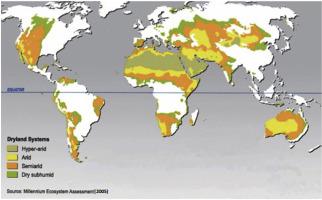当前位置:
X-MOL 学术
›
Int. J. Parasitol. Parasites Wildl.
›
论文详情
Our official English website, www.x-mol.net, welcomes your feedback! (Note: you will need to create a separate account there.)
Untapped potential: The utility of drylands for testing eco-evolutionary relationships between hosts and parasites.
International Journal for Parasitology: Parasites and Wildlife ( IF 1.8 ) Pub Date : 2020-05-16 , DOI: 10.1016/j.ijppaw.2020.04.003 Elizabeth M Warburton 1
International Journal for Parasitology: Parasites and Wildlife ( IF 1.8 ) Pub Date : 2020-05-16 , DOI: 10.1016/j.ijppaw.2020.04.003 Elizabeth M Warburton 1
Affiliation

|
Drylands comprise over 41% of all terrestrial surface area and are home to approximately 35.5% of the world's population; however, both free-living and parasitic fauna of these regions remain relatively understudied. Yet, the very conditions that make these regions challenging to study - extreme environmental conditions and low population density for various organisms - also make them potentially untapped natural laboratories for examining eco-evolutionary relationships between hosts and parasites. Adaptations and ecological patterns illustrated by desert parasite communities can serve as exemplars within the extremes regarding the evolution of virulence, breadth of host spectra, and lifecycle strategies. This review provides relevant examples for each of these three topics using parasites from dryland regions in order to encourage future empirical tests of hypotheses regarding parasite ecology and evolution within dryland ecosystems and stimulate wider investigation into the parasitofauna of arid regions in general. As global climate changes and anthropogenic disturbance increases, desertification is a growing problem which has been labeled as a threat to global health. Thus, deserts not only provide useful natural laboratories in which to study parasite transmission but understanding parasite transmission within these habitats becomes increasingly important as larger, likely highly resource insecure, populations are projected to live on the margins of desert regions in the future.
中文翻译:

未开发的潜力:干旱地区用于测试寄主和寄生虫之间生态进化关系的工具。
旱地占陆地总面积的41%以上,约占世界人口的35.5%;然而,这些地区的自由生活和寄生动物区系仍然研究不足。但是,使这些地区难以研究的正是这些极端条件-极端环境条件和各种生物的低种群密度-也使它们成为潜在的尚未利用的自然实验室来研究寄主与寄生虫之间的生态进化关系。极端情况下,沙漠寄生虫群落所表现出的适应性和生态模式可以作为毒力进化,宿主谱广度和生命周期策略的典范。这篇综述使用干旱地区的寄生虫为这三个主题中的每一个提供了相关的实例,以鼓励将来对干旱地区生态系统中的寄生虫生态学和进化的假设进行实证检验,并激发对干旱地区寄生虫动物的广泛调查。随着全球气候变化和人为干扰的增加,荒漠化是一个日益严重的问题,已被标记为对全球健康的威胁。因此,沙漠不仅提供有用的自然实验室来研究寄生虫的传播,而且随着更大,可能极度资源不安全的人口在未来生活在沙漠地区的边缘,了解这些栖息地内的寄生虫传播变得越来越重要。
更新日期:2020-05-16
中文翻译:

未开发的潜力:干旱地区用于测试寄主和寄生虫之间生态进化关系的工具。
旱地占陆地总面积的41%以上,约占世界人口的35.5%;然而,这些地区的自由生活和寄生动物区系仍然研究不足。但是,使这些地区难以研究的正是这些极端条件-极端环境条件和各种生物的低种群密度-也使它们成为潜在的尚未利用的自然实验室来研究寄主与寄生虫之间的生态进化关系。极端情况下,沙漠寄生虫群落所表现出的适应性和生态模式可以作为毒力进化,宿主谱广度和生命周期策略的典范。这篇综述使用干旱地区的寄生虫为这三个主题中的每一个提供了相关的实例,以鼓励将来对干旱地区生态系统中的寄生虫生态学和进化的假设进行实证检验,并激发对干旱地区寄生虫动物的广泛调查。随着全球气候变化和人为干扰的增加,荒漠化是一个日益严重的问题,已被标记为对全球健康的威胁。因此,沙漠不仅提供有用的自然实验室来研究寄生虫的传播,而且随着更大,可能极度资源不安全的人口在未来生活在沙漠地区的边缘,了解这些栖息地内的寄生虫传播变得越来越重要。


























 京公网安备 11010802027423号
京公网安备 11010802027423号